Guide By – Los Angeles Pedestrian Accident Attorney
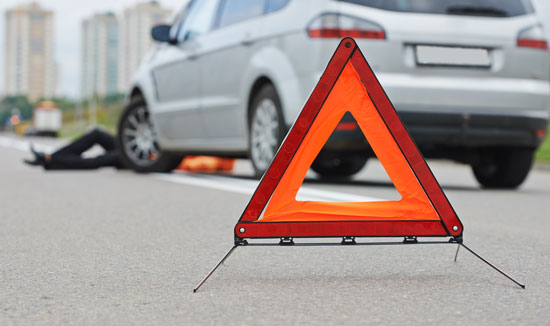 We routinely cross streets without giving much thought to this task or the potential dangers associated with it. Yet, every year, thousands of Americans are killed or injured while navigating the Nation’s streets, crosswalks, sidewalks, and intersections. Cherepinskiy Law Firm, Los Angeles pedestrian accident attorney, is a zealous fighter on behalf of the victims of pedestrian accidents and their families. This firm’s extensive litigation, courtroom, and trial expertise make it a formidable force in the battle for financial compensation for victims’ injuries. Cherepinskiy Law Firm uses unique legal strategies and modern technology to successfully pursue every case from the initial investigation through trial.
We routinely cross streets without giving much thought to this task or the potential dangers associated with it. Yet, every year, thousands of Americans are killed or injured while navigating the Nation’s streets, crosswalks, sidewalks, and intersections. Cherepinskiy Law Firm, Los Angeles pedestrian accident attorney, is a zealous fighter on behalf of the victims of pedestrian accidents and their families. This firm’s extensive litigation, courtroom, and trial expertise make it a formidable force in the battle for financial compensation for victims’ injuries. Cherepinskiy Law Firm uses unique legal strategies and modern technology to successfully pursue every case from the initial investigation through trial.
Pedestrian safety is extremely important. In the recent years, this issue has become more significant than ever. More and more people make efforts to lead healthy lifestyles and, as a result, there has been an increase in the number of people who walk, jog, and run on a daily basis.
The term “pedestrian” includes anyone who is not using a motor vehicle, motorcycle, or a bicycle. Pedestrians are those individuals who travel on foot or use skateboards, roller skates, scooters, hoverboards, skateboards, and other similar conveyances. Individuals with disabilities who use wheelchairs, tricycles, quadricycles, and other similar modes of transportation are also considered to be pedestrians.
Pedestrian Accident Statistics
Research data indicates that:
- Pedestrians are significantly more vulnerable than motor vehicle drivers and passengers. Every time a passenger vehicle takes a trip, its occupants are 1.5 times less likely than pedestrians to be killed in a car accident.
- If a pedestrian is hit by an automobile, his or her likelihood of survival directly depends on the speed of the vehicle. If a motor vehicle strikes a pedestrian while traveling at the speed of 20 miles per hour, the victim’s probability of survival is high at approximately 90%. However, if the vehicle is moving at the speed of 40 miles per hour, the victim’s likelihood of survival drops dramatically – to roughly 20%.
Pedestrian Fatalities in the United States
In the United States, approximately 75,000 pedestrians are killed or injured every year on the Nation’s roads, crosswalks, sidewalks, and intersections.
The statistical data from the National Highway Traffic Safety Administration (“NHTSA”) shows that the number of pedestrian fatalities in the United States is on the rise. Two pedestrians are killed approximately every 3 hours as a result of traffic crashes. NHTSA reports the following data with respect to the number of pedestrians killed in traffic accidents during the period of 1997 through 2016:
– YEAR Pedestrian Fatalities
– 1997 5,321
– 1998 5,228
– 1999 4,939
– 2000 4,763
– 2001 4,901
– 2002 4,851
– 2003 4,774
– 2004 4,675
– 2005 4,892
– 2006 4,795
– 2007 4,699
– 2008 4,414
– 2009 4,109
– 2010 4,302
– 2011 4,457
– 2012 4,818
– 2013 4,779
– 2014 4,910
– 2015 5,495
– 2016 5,987
In 2016, the number of pedestrians who died as a result of being hit by a motor vehicle was 5,987, which represents the highest number of annual fatalities since 1990.
Based on the statistical data from the NHTSA, in 2016:
- The average rate of pedestrian fatalities was approximately 1 pedestrian death for every 1.5 hours.
- Pedestrian fatalities represented 16% of all traffic-related deaths.
- Males represented 70 percent of all pedestrians who were killed as a result of traffic accidents.
- Almost half (48%) of all pedestrian fatalities involved drivers (13%) and pedestrians (33%) with alcohol intoxication – i.e. with blood alcohol concentration (BAC) level of 0.08 g/dL or higher.
- Nine out of ten (90%) of pedestrians who died due to traffic accidents – were involved in single-vehicle accidents. Most of these pedestrians were killed as a result of frontal impacts by passenger cars, minivans, pickups, SUVs, and full-size vans.
- Hit-and-run drivers killed 20% of all pedestrians who died in motor vehicle accidents.
Pedestrian Deaths in California
- In California, among all traffic-related deaths, pedestrian fatalities represent approximately 22 percent.
- In 2016, out of the 5,987 pedestrian fatalities that occurred in all of the states combined, 867 pedestrian fatalities (14.48%) took place in California.
Pedestrian Fatalities in Los Angeles County
- In 2016, there were 265 pedestrian deaths in Los Angeles County, which represented the highest number of pedestrian fatalities among all counties in the United States.
Pedestrian Deaths in the City of Los Angeles
Based on the review of the statistical data by the Los Angeles pedestrian accident attorney at Cherepinskiy Law Firm, the number of pedestrian fatalities in the city are frightening.
- In Los Angeles, every 40 hours, a pedestrian is killed as a result of a traffic accident.
- Among major U.S. cities, Los Angeles holds the record as the city with the highest rate of annual traffic -related deaths. Specifically, in Los Angeles, there are 6.27 fatalities per 100,000 city residents.
- Based on the statistical data from the Los Angeles Department of Transportation (“LADOT”), crashes involving pedestrians and bicycle riders account for only 14% of all traffic accidents in the city. Nevertheless, these collisions result in nearly 50% of all traffic -related fatalities that occur in the city.
- In 2017, the numbers of pedestrians killed in traffic accidents was 134, which was the highest number of fatalities in over fifteen years.
The Most Hazardous Intersections in Los Angeles
Based on a study by Los Angeles Times (LA Times), almost 25 percent of all crashes in the city that involve pedestrians – take place at less than 1 percent of intersections. Some of the city’s most hazardous intersections are located in densely-populated areas, which include Hollywood, downtown Los Angeles, Westlake, and Koreatown. In Los Angeles, based on the study in the LA Times, the 5 most unsafe intersections are as follows:
– Devonshire Street & Reseda Boulevard (Northridge);
– Imperial Highway & Vista Del Mar (Playa Del Rey);
– Balboa Boulevard & Nordhoff Street (Northridge);
– Firestone Boulevard & Lakewood Boulevard (Downey); and
– Lindley Avenue & Roscoe Boulevard (Los Angeles).
Types of Pedestrian Accident Injuries
A pedestrian accident may lead to serious and catastrophic injuries, as well as a fatality. The following is the listing of the most common injuries that can be caused when pedestrians are hit by motor vehicles:
- Amputation and loss of limbs
- Back and neck injuries
- Bruising
- Blindness and eye injuries
- Burns
- Concussions
- Crush Injuries
- Cuts and scrapes
- Disfigurement and permanent scarring
- Fractures and broken bones (non-displaced, displaced, and compound fractures)
- Hearing Loss
- Hematomas (Internal bleeding)
- Internal injuries
- Joint Damage
- Post-Traumatic Stress Disorder (PTSD)
- Skin Injuries
- Soft tissue injuries
- Spinal cord injury and paralysis
- Traumatic brain injury (“TBI”)
- Whiplash
- Wrongful death
If you have suffered an injury or a loved one’s death as a result of a pedestrian accident, you need the assistance of a Los Angeles pedestrian accident attorney.
Common Causes of Pedestrian Accidents
 Most pedestrian accidents and fatalities occur as a result of the following types of inappropriate driver behavior:
Most pedestrian accidents and fatalities occur as a result of the following types of inappropriate driver behavior:
- Distractions (e.g. texting or talking on a mobile phone, putting makeup on, eating, etc.) and
- Driving under the influence of alcohol and/or drugs.
Nevertheless, it is worth noting that pedestrians themselves play a tremendous role in their own safety. Causing accidents while being under the influence – is not limited to drivers only. Statistical data shows that a third of pedestrian fatalities involve pedestrians with alcohol intoxication.
Implementation of Vision Zero Initiative
In August of 2015, the Mayor of Los Angeles, Eric Garcetti, issued Executive Directive #10 and officially started the “Vision Zero Initiative”. The goal of this initiative is to aim for the reduction of traffic-related deaths to absolute zero through a series of improvements in the City’s crosswalks and pedestrian safety devices.
Sweden is the World’s pioneer in the Vision Zero concept. Specifically, in 1997, the Swedish government approved this safety-enhancing policy. Instead of placing the blame for traffic deaths on drivers, the Vision Zero philosophy is to implement a system-wide overhaul of traffic safety, including changes in the infrastructure and technology. Sweden’s invention has been very successful and resulted in a 50% reduction in pedestrian fatalities.
The Los Angeles’ Vision Zero plan includes the following pedestrian safety enhancements:
- Scramble Crosswalks stop traffic in all 4 directions during the period when crossing is allowed. This type of a crosswalk allows pedestrians to walk through a particular intersection in absolutely all directions – even diagonally. Based on a study cited by the Los Angeles Department of Transportation, scramble crosswalks can potentially reduce the incidents of motor vehicles colliding with pedestrians by 35%.
In Los Angeles, the first such crosswalk was installed in November of 2015 at the intersection of Hollywood Boulevard and Highland Avenue.
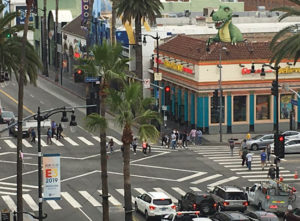
- Curb Extensions “tighten” intersections by widening sidewalks and making streets narrower. The street narrowing is achieved both visually and physically with the use of concrete, paint, and reflective materials. This method of intersection tightening results in the following safety improvements: the distance people need to walk in order to cross the street is reduced; pedestrians become more visible to drivers; and when making turns, vehicles slow down.

- Pedestrian Paddle Signs are vertical rectangular warning signs, which state in large letters that motorists are required by law to yield to pedestrians who are using crosswalks. Based on their shape, these signs are commonly referred to as “paddles”. Paddle signs are typically yellow in color and installed in the middle of the street (between the lanes), which is intended to make drivers reduce their speed when approaching crosswalks.

- Speed Feedback Signs, also known as “radar speed signs” and “dynamic speed displays”, utilize radar technology to display drivers’ current speed. These interactive signs are designed to have a traffic calming effect and encourage speeding drivers to slow down. Statistical data shows that speed feedback signs are effective and, typically, drivers who see their speed displayed reduce their speed by at least 10-20%.

- Leading Pedestrian Intervals (LPI) provide pedestrians with a head start when they cross an intersection at the same time when the vehicle traffic moving in the same direction has a green light.
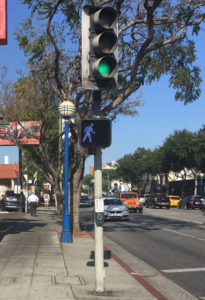
Typically, this head start lasts 3 to 7 seconds, but it can be as long as 10 seconds. Some of these LPI intersections are equipped with detailed instructions for pedestrians.
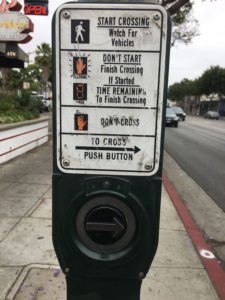
If an LPI is in operation, a “walk” signal instructs pedestrians to start crossing the intersection and, several seconds later, the street light turns green allowing vehicles to start moving. This system is designed to increase pedestrian visibility and remind drivers who are making turns (especially right turns) that pedestrians have the right-of-way and vehicles have to yield to them.
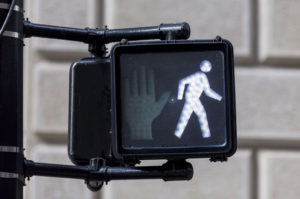
- Pedestrian – Activated Flashing Beacons are yellow light emitting diode (LED) lights installed at intersections without traffic signals or crosswalks located in the middle of a city block. These safety beacons are typically solar-powered. They are activated either by pedestrians themselves who have to push a button or by automatic pedestrian detection systems. Once activated, the beacons start flashing in an irregular pattern, which is similar to the flashing pattern used by police vehicles. The flashing lights are intended to enhance pedestrian visibility and alert approaching drivers that someone is crossing the street.

- Raised Medians & Pedestrian Refuge Islands create an opportunity for pedestrians to stand in the middle of a wide crosswalk after crossing only “half” of the street – i.e. only one direction of traffic. Raised medians and refuge islands allow people to wait in safety before they can finish crossing the street. These safety enhancements are designed to reduce instances of people running to “make it” across the street or having to finish crossing when the light has already turned red.
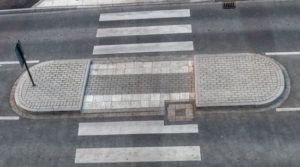
- Traffic Lights with Left Turn Arrows serve to reduce the number of accidents when motor vehicles hit pedestrians. Left turn arrows allow drivers to make left turns at a specific designated time and without having to yield to oncoming vehicle traffic. This reduces the risk of drivers focusing on the right opportunity to make a turn and failing to see that there are pedestrians crossing the street at the same time.
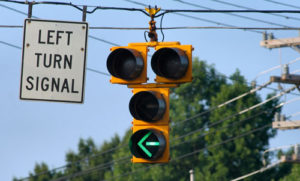
Walking Guidelines for Pedestrian Safety
As the Los Angeles pedestrian accident attorney, Cherepinskiy Law Firm provides the following overview of the walking guidelines for pedestrian safety:
In California, pedestrians have the right-of-way. Nevertheless, they have an obligation to follow traffic rules as well. The National Highway Traffic Safety Administration (“NHTSA”) and the California Department of Motor Vehicles (“DMV”) recommend the following pedestrian safety guidelines, which should be followed by pedestrians:
- In most situations, regardless of whether crosswalks are marked or unmarked, drivers of motor vehicles are obligated to yield the right-of-way to those pedestrians who are crossing streets. However, when making a turn, a driver may not see a pedestrian in his or her path. When crossing a street – always be careful.
- When crossing streets, if it is possible, use designated crosswalks or intersections with traffic lights. Drivers expect to see pedestrians in these areas. Before you start crossing the street, always do the following: 1) stop; 2) look left; 3) look right; and 4) look left once again.
- While you are in a crosswalk, do not make unnecessary stops because such stops cause traffic delays and disruptions.
- Do not create traffic hazards by abruptly leaving a curb or otherwise making sudden appearances in front of oncoming vehicles.
- If your view of the street is blocked by a parked car, before you start crossing the street, stop at the line parallel to the edge of the car and take a careful look at the street to make sure there are no approaching vehicles.
- If you need to cross a street and there is no available intersection or a crosswalk, do the following: always wait for a gap in the flow of traffic in both directions, which is large enough to allow you to safely cross the street. As you are crossing the street, make sure you continue to watch for any unexpected changes in traffic. Speeding cars tend to appear “out of nowhere”. Also, if you are walking at night, before you cross, find an area of the street that is well-lit.
- Use a sidewalk whenever it is possible. If there is no available sidewalk or a path, and you absolutely have to walk in the street – it is crucial to walk while facing traffic.
- Avoid distractions such as smart phones, audio players, and other electronic devices that can divert your attention away from the road.
- Make sure you are visible. During the day, wear brightly colored clothing. If you have to walk at night, use a flashlight or wear clothing with reflective elements.
- Do not walk while under the influence of alcohol or drugs. These substances impair peoples’ balance, judgment, focus, coordination, and reaction time.
- Overall, one can never be too cautions when sharing the road with motor vehicles. Do not rely on drivers to see you and never make an assumption that a driver sees you. A driver may not see you for a variety of reasons, including alcohol or drug impairment, distractions, poor lighting or visual obstructions such as trees. When a vehicle is approaching you, always make eye contact with the driver!
General Driving Guidelines for Pedestrian Safety
The NHTSA and the California DMV recommend that all drivers recognize and obey the following general driving guidelines, which are designed to promote the safety of pedestrians on our roadways:
- Always be on a lookout for pedestrians. Inclement weather, poor lighting, or physical obstructions such as buildings or trees may prevent you from seeing people. Some pedestrians may potentially violate traffic rules and cross the street where they are not supposed to. In other words, there are multiple reasons why a pedestrian may suddenly appear in your way – be vigilant.
- If you are under the influence of alcohol and/or drugs, do not drive! Arrange for an alternative transportation method.
- Always obey speed limits. When pedestrians are around – slow down.
- Be aware of your surroundings. If you are in a location where the presence of children is expected – such as residential neighborhoods and school zones – slow down and drive very carefully.
- Never drive on sidewalks. The only exception to this rule is – you are allowed to cross a sidewalk if you are entering or exiting an alley or a driveway. If you are crossing a sidewalk, remember to always yield to pedestrians.
- If you are driving an electric or a hybrid vehicle, be extra careful when driving next to or approaching pedestrians. These vehicles are essentially silent while in motion, and a pedestrian may not realize there is an approaching car. Be especially careful when you are near blind pedestrians, because they rely on engine sound and may assume there are no vehicles around them.
California Right-of-Way Rules for Pedestrians
In addition to the general driving guidelines applicable to pedestrians, California has specific “right-of-way” laws and rules that emphasize the importance of pedestrian safety. Based on the statistical data, many pedestrians are injured or killed as a result of right-of-way violations by California’s motorists. Specific road locations have their own sets of rules and guidelines as follows:
Crosswalks
Crosswalks are specifically designated to be used by pedestrians. The vast majority of crosswalks are found at street corners, but “mid-block” crosswalks exist as well. Typically, crosswalks are marked with: 1) painted white lines for general public and 2) yellow lines in school areas. In residential areas, crossings are not marked at all. With respect to the safety of pedestrians who are crossing the street, drivers must always obey these right-of-way rules:
- Drivers must always – under all circumstances – STOP for any pedestrians, regardless of the location of the crosswalk, and the presence or absence of painted lines, flashing lights or traffic lights!
- Reduce speed while approaching crosswalks.
- If you see one or more vehicles stopped at a crosswalk – never pass these vehicles! One of the reasons why these vehicles are stopped could be to let a pedestrian you cannot see cross the street.
- Before you make a turn at a street corner or an intersection, always watch for potential pedestrians who are ready to start crossing the street.
- If a person makes eye contact with you, this means he or she is about to start crossing the street. You must always yield to the pedestrians.
- Never stop in a crosswalk itself. People who are crossing the street will have to walk around your vehicle, which will create a pedestrian safety hazard.
- Some people may need a longer time to cross the street: (1) elderly individuals; (2) people with disabilities; and (2) pedestrians who are crossing the street with young children both on foot and in strollers. Remain stopped until they have fully crossed the street.
Intersections
Intersections include any locations where two different roadways “meet” each other – typically, at a 90-degree angle. Based on the data from the Federal Highway Administration (“FHA”), over 20% of reported fatalities in the United States involve intersection crashes.
- When you make a left or right turn, always check for pedestrians.
- If you are approaching an intersection that does not have a “STOP” or “YIELD” sign, yield to those pedestrians who are either just entering or already inside the intersection. If this is a “T”-shaped intersection, pedestrians on the “through” road have the right-of-way; yield to them.
Roundabouts
Roundabouts are a type of an intersection where vehicles move counter-clockwise around an elevated or blocked central area called an “island”. When exiting or entering a roundabout, always watch for pedestrians and yield to them.
What Damages Can be Recovered in Pedestrian Accident Cases?
Victims of pedestrian accidents can claim the following two main types of damages: Non-Economic and Economic damages. In some situations, those who have been injured as a result of a pedestrian accident may potentially seek Punitive Damages. In order to obtain maximum compensation, you need the assistance of pedestrian accident lawyer Los Angeles residents can rely on for justice. For cases involving future care, Cherepinskiy Law Firm retains top expert physicians, life care planners, and economists to evaluate clients’ needs and present the best case on their behalf. A detailed discussion of the recoverable damages is included on the Personal Injury Damages page of this website.
If a pedestrian accident resulted in the death of a loved one, then compensation can be sought in a Wrongful Death action.
Get a Free Consultation! Promptly Contact the Pedestrian Accident Lawyer Los Angeles Residents Can Count On
If you believe your injuries or a loved one’s death occurred as a result of a pedestrian accident, please call or fill out an electronic contact form today to request a free consultation. Cherepinskiy Law Firm, as the Los Angeles pedestrian accident lawyer, will work in a tireless and compassionate manner in a personal injury or a wrongful death case to make sure you are compensated for your injuries and losses.
This firm fights for clients throughout California, including Los Angeles, Orange County, as well as Ventura, Riverside and San Bernardino Counties.
Sources
1. http://visionzero.lacity.org
2. https://www.dmv.ca.gov/portal/dmv/detail/pubs/hdbk/right_of_way
3. https://www.cdc.gov/motorvehiclesafety/pedestrian_safety/index.html







